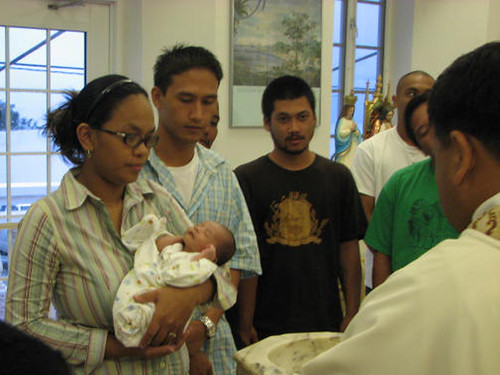Relationship between a godmother and child’s parents
Kumaire, is religious and social term to describe the relationship between parents and their child’s godmother, borrowed from the Spanish comadre and appropriated into Chamorro/CHamoru cultural tradition. Måle’ is the shortened form of kumaire and is commonly used when a mother and her child’s godmother refer to one another, and is also used by the child’s father when addressing his child’s godmother.
Måle’ is religious because the relationship is initially established in the Catholic ceremony of baptism, or baotismo in Chamorro. This relationship is also social and cultural because it serves as a vehicle through which Chamorro familial and clan social networks, prestige, and resources are expanded.
Kompaire system
A måle’ and a kompåiri (godfather, shortened to påri) and parents of a child form a ”kompaire” system. These relationships serve to strengthen Chamorro traditional values. To the Chamorros, who are predominantly Catholic due to a history of Spanish colonization that dates back to the 17th century, the religious and social relationship established between a child’s godparents and parents correlates with the social worldview of inafa’maolek, which means to make things good. It envelopes the theme of reciprocation which is a vital practice in Chamorro culture.
Godparents are also responsible for helping their godchildren understand their cultural heritage. If a child’s parents were to die, it is expected that their godparents will look after the child’s material and spiritual needs.
The måle’ relationships become part of a larger social system that contributes to the social well-being of the entire clan by expanding the family’s social network, support system, and access to resources. Responsibilities of raising a child are thus shared, spreading the ethic of accountability within the larger group or clan.
Role of a måle’
A måle’ plays an integral role in the religious and social formative life of the godchild. In terms of religious formation, she ensures that her godchild receives the necessary church sacraments such as Holy Communion, Confirmation, Marriage, and in some cases Anointing of the Sick and Ordination.
When a godchild is baptized it is the godmother’s responsibility to select and purchase the christening garment called a bata’ and the needed accessories. The måle’ also helps the mother dress the child in the bata’ during the church ceremony. She is also usually responsible for providing a cake at the christening party and during her godchild’s birthdays. When a female godchild gets married, it is the måle’ who is again responsible for providing a wedding cake among other chenchule’(monetary or material gifts). During the wedding ceremony both the måle’ and påri serve as witnesses.
In terms of socialization and enculturation, a måle’ participates in the personal and significant events of her godchild’s life such as birthdays, Christmas, graduation and other achievements. Being a måle’ is tantamount to being a second mother.
Perpetuation of culture
The importance of the role that a godmother plays in a child’s life in Chamorro culture is described in a popular Guam legend of a young girl named Sirena who was turned into a mermaid after her godmother saved her from a curse.
In the legend, Sirena was a Chamorro girl whose love for swimming caused her to often neglect her chores. One day Sirena’s mother sent her to get coals for the iron, but on her way to complete her errand Sirena was tempted by the river water and began swimming, eventually losing all sense of time. When her mother discovered that Sirena was swimming instead of collecting the coal, she angrily cursed Sirena saying that if she loved swimming so much she should turn into a fish. Sirena’s godmother, who was visiting, heard the curse and said that because she is Sirena’s godmother, half of the girl belonged to her, and that the upper half of Sirena’s body shall remain human. Sirena’s lower body was then transformed and she swam away never to be seen by her family again.
Although roles and responsibilities associated with the kumaire today may vary from family to family, the root of this system is steeped in the Chamorro worldview of Inafa’maolek and, therefore, necessary for perpetuation of Chamorro life.
For further reading
Catechism of the Catholic Church. Vatican City: Liberia Edtirice Vaticana, 1993.
Chamorro Heritage, A Sense of Place: Guidelines, Procedures and Recommendations For Authenticating Chamorro Heritage. The Hale’-ta Series. Hagåtña: Department of Chamorro Affairs, Research, Publication, and Training Division, 2003.
Hattori, Anne Perez. Colonial Dis-ease: U.S. Navy Health Policies and the Chamorros of Guam, 1898-1941. Pacific Islands Monograph Series 19. Honolulu: University of Hawai’i Press, 2004.
Jorgensen, Marilyn A. Guam’s Patroness: Santa Marian Kamalen. N.p., 1994.
Quan, John F. “The Compradrazgo System of Guam.” PhD diss., Marquette University, 1976.
Rogers, Robert. Destiny’s Landfall: A History of Guam. Honolulu: University of Hawai’i Press, 1995.




